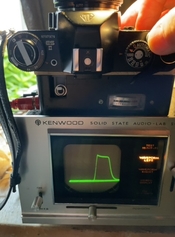I just finished evaluating some focal plane shutters and wanted to share the information as I found very little on this topic from the internet.
Before building the tester, one needs to know which information is needed. For a focal plane shutter, the fast speeds need special consideration, seeing as the mirror is up for a 1/60 (or higher) during the entire exposure, even though each individual portion of the film only receives light for example 1/1000 of a second.
To measure this one would need a theoretic point source from which the time the opening curtain passes to the time the closing curtain passes could be measured.
Then, to ensure evenness across the film plane, this measurement needs to be carried out near the opening side of the film gate and also near the closing side and in the middle too.
The design of many focal plane shutters (the one's I'm currently working on) fix the curtain velocity and mechanically release the closing curtain at mathematical 1/2s of the shutter gate. For example
Second Curtain Release:
1/60 = 36mm (full gate distance)
1/125 = 18mm (half gate distance)
1/250 = 9mm (1/4 gate distance)
1/500 = 4.5mm (1/8 gate distance)
1/1000 = 2.25mm (1/16 gate distance)
We also know that without a mechanical modification to a cam, these divisions are fixed, so changing one changes all the others.
The most sensitive to error in second curtain release is the fastest, 1/1000. A small error in curtain timing will cause a huge exposure change at 1/1000. Also, if the curtains don't travel at the same speed, any narrowing or opening of the slit will also have a big side-to-side effect on exposure at 1/1000 vs the slower speeds.
So, 1/60 exposure allows one to estimate curtain velocity and 1/1000 exposure is the best to evaluate slit width and evenness. So, most of the tests will be on these two speeds.
Before building the tester, one needs to know which information is needed. For a focal plane shutter, the fast speeds need special consideration, seeing as the mirror is up for a 1/60 (or higher) during the entire exposure, even though each individual portion of the film only receives light for example 1/1000 of a second.
To measure this one would need a theoretic point source from which the time the opening curtain passes to the time the closing curtain passes could be measured.
Then, to ensure evenness across the film plane, this measurement needs to be carried out near the opening side of the film gate and also near the closing side and in the middle too.
The design of many focal plane shutters (the one's I'm currently working on) fix the curtain velocity and mechanically release the closing curtain at mathematical 1/2s of the shutter gate. For example
Second Curtain Release:
1/60 = 36mm (full gate distance)
1/125 = 18mm (half gate distance)
1/250 = 9mm (1/4 gate distance)
1/500 = 4.5mm (1/8 gate distance)
1/1000 = 2.25mm (1/16 gate distance)
We also know that without a mechanical modification to a cam, these divisions are fixed, so changing one changes all the others.
The most sensitive to error in second curtain release is the fastest, 1/1000. A small error in curtain timing will cause a huge exposure change at 1/1000. Also, if the curtains don't travel at the same speed, any narrowing or opening of the slit will also have a big side-to-side effect on exposure at 1/1000 vs the slower speeds.
So, 1/60 exposure allows one to estimate curtain velocity and 1/1000 exposure is the best to evaluate slit width and evenness. So, most of the tests will be on these two speeds.



